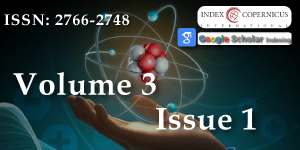Natural ferromagnetic resonance in cast microwires and its application to the safety control of infrastructures
Main Article Content
Abstract
The natural ferromagnetic resonance (NFMR) in cast glass-coated amorphous magnetic microwires has been studied theoretically and experimentally. The NFMR reveals large residual stresses appearing in the microwire core in the course of casting. These stresses, together with the magnetostriction, deteRmine the magnetoelastic anisotropy. Beside the residual internal stresses, the NFMR frequency is influenced by external stresses applied to the microwire or to the composite containing the latter (the so-called stress effect).
The dependence of the NFMR frequency on the deformation of the microwires is proposed to be used in the distant diagnostics of dangerous deformations of critical infrastructure objects such as bridges, dams, wind turbine towers, skyscrapers, stack-furnaces, embankments, etc. To this end, fragments of magnetic microwires will be embedded in the bulk of concrete structures or fixed on their surface during construction or after it by means of coating with a special concrete-adhesive plaster. Further, these structures are periodically irradiated with microwaves from a radar at frequencies close to the original NFMR, and the presence of latent dangerous deformations of the concrete structure is judged by the NFMR frequency shift.
Article Details
Copyright (c) 2020 Adar E, et al.

This work is licensed under a Creative Commons Attribution 4.0 International License.
The International Journal of Physics Research and Applications is committed in making it easier for people to share and build upon the work of others while maintaining consistency with the rules of copyright. In order to use the Open Access paradigm to the maximum extent in true terms as free of charge online access along with usage right, we grant usage rights through the use of specific Creative Commons license.
License: Copyright © 2017 - 2025 |  Open Access by International Journal of Physics Research and Applications is licensed under a Creative Commons Attribution 4.0 International License. Based on a work at Heighten Science Publications Inc.
Open Access by International Journal of Physics Research and Applications is licensed under a Creative Commons Attribution 4.0 International License. Based on a work at Heighten Science Publications Inc.
With this license, the authors are allowed that after publishing with the journal, they can share their research by posting a free draft copy of their article to any repository or website.
Compliance 'CC BY' license helps in:
| Permission to read and download | ✓ |
| Permission to display in a repository | ✓ |
| Permission to translate | ✓ |
| Commercial uses of manuscript | ✓ |
'CC' stands for Creative Commons license. 'BY' symbolizes that users have provided attribution to the creator that the published manuscripts can be used or shared. This license allows for redistribution, commercial and non-commercial, as long as it is passed along unchanged and in whole, with credit to the author.
Please take in notification that Creative Commons user licenses are non-revocable. We recommend authors to check if their funding body requires a specific license.
Taylor GF. A metod of drawing metallic filaments and a discussion of their properties and users. Phys Rev. 1924; 23: 655-660.
Vázquez M. Soft magnetic wires, Physica B: Condensed Matter. 2001; 299: 302-313.
Vazquez M, Zhukov AP. Magnetic properties of glass-coated amorphous and nanocrystalline microwires. J Magn Magn Mat. 1996; 160: 223-228.
Baranov SA, Larin VS, ToRcunov AV. Technology, preparation and properties of the cast glass-coated magnetic microwires. Crystals. 2017; 136: 1-12.
Antonov AS, Borisov VT, Borisov OV, Prokoshin AF, Usov NA. Residual quenching stresses in glass-coated amorphous ferromagnetic microwires. J Phys D Appl Phys. 2000; 33: 1161-1168.
Baranov SA. Use of a microconductor with natural ferromagnetic resonance for radio-absorbing materials Tech. Phys. Lett. 24, 1998, 549-550.
Baranov SA, Yamaguchi M, GaRcia KL, Vazquez M. Dimensional absorption high-frequency properties of the cast glass coated microwires. Surf Engin Appl Electrochem. 2008; 44: 425 -427.
Baranov SA. Engineering microwave properties of microwires. Moldavian J Phys Sci. 2015; 14: 201-214.
Marín P, Cortina D, Hernando A. High-frequency behavior of amorphous microwires and its applications. J Magn Magn Mater. 2005; 290–291, 2005, 1597-1600.
Peng HX, Qin F, Phan MH. in Ferromagnetic microwires composites: from sensors to microwave applications. Springer. Switzerland 2016; 12-14.
Qin F, Peng HX. Ferromagnetic microwires enabled multifunctional composite materials. Progr Mater Sci. 2013; 58: 183-259.
Kraus L, Infante G, Frait Z, Vázquez M. Ferromagnetic resonance in microwires and nanowires. Phys Rev B. 2011; 83: 1-11.
Kraus L. Theory of ferromagnetic resonances in thin wires. Czech J Phys. 1982; 32: 1264-1282.
Reynet O, Adenot AL, Deprot S, Acher O, Latrach M. Effect of the magnetic properties of the inclusions on the high-frequency dielectric response of diluted composites. Phys Rev B. 2002; 66: 1-9.
Starostenko SN, Rozanov KN, Osipov AV. Microwave properties of composites with glass coated amorphous magnetic microwires. J Magn Magn Mater. 2006; 298: 56-64.
Yıldız F, Rameev BZ, Tarapov SI, Tagirov LR, Aktaş B. High-frequency magnetoresonance absorption in amorphous magnetic microwires. J Magn Magn Mater. 2002; 247: 222-229.
Ménard D, Britel M, Ciureanu P, Yelon A. Giant magnetoimpedance in a cylindrical magnetic conductor. J Appl Phys. 1998; 84: 2805-2814.
Ménard D, Yelon A. Theory of longitudinal magnetoimpedance in wires. J Appl Phys. 2000; 88: 379-393.
Nematov MG, Adam AM, Panina LV, Yudanov NA, Dzhumazoda A, et al. Magnetic anisotropy and stress-magnetoimpedance (S-MI) in current-annealed Corich glass-coated microwires with positive magnetostriction. J Magn Magn Mater. 2019; 474: 296-312.
Baranov SA. Generalized conductivity and optimum energy release. Tech Phys. 1999; 44: 853-854.
Born M, Wolf E. In Principles of Optics: Electromagnetic Theory of Propagation. Interference and Diffraction of Light, Pergamon Press, Oxford. 1970; 30.
Makhnovskiy D, Zhukov A, Zhukova V, Gonzalez J. Tunable and self-sensing microwave composite materials incorporating ferromagnetic microwires. Adv Sci Technol. 2008; 54: 201-210.

